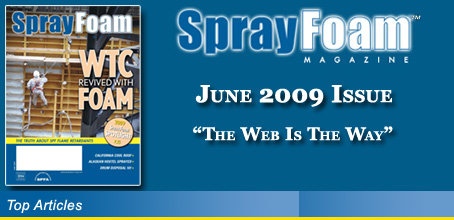
Published Articles

THE FUTURE OF INSULATION MARKETING By Steve Lawrence and Kenneth Hodges, owners of InsulationMarketingNetwork.com
In these economic times, no matter what type of business you have, your market has drastically changed. Your customers have changed. The way that you will market to your future customers has also changed. Even our traditional method of having salespersons call on new construction has changed.
For many of us, our attempts to use traditional advertising such as newspaper, radio, television or direct mail to capture market share have been less than successful; the return on investment (ROI) was never enough. Today, we no longer have to use a shotgun approach to find those customers. We let them find us. Whether you do retrofit or new construction, The Web is the Way to market your business.
Customers are now more informed about our products and their needs than ever before. As well as everyday shopping, they use the Web to search for contractors, products, services, and prices. They use the Web to research everything going into their buildings and homes and they expect to meet contractors who can present themselves as informed professionals. Lowest price is not always their primary concern.
Should you think that the people in your town are different and don’t often use the Internet to search, consider these facts: Across the U.S., about 61 percent of all households use the Internet to search for cars, clothes, toys and, yes, insulation. Add to that, those who “only” search at work, and that goes up to 70 percent. For households above $50,000.00 per year, that figure climbs to 88 percent. Go above $75,000 per year in household income and the percentage of Internet searching soars to 98 percent.
Without a fully functioning and properly marketed Web site, your customers are searching for you, but finding your competition instead!
During the month of July 2008, Google did nine billion searches. One million eight hundred thousand of those were in the Continental United States and had some form of “insulation” attached as a keyword. Again, in the U.S., 130,000 searches in July were for “spray foam” alone. These customers have already heard of the excellent insulating and air sealing qualities of spray polyurethane foam (SPF) and have decided to talk with a, SPF contractor. When they search for their local SPF contractor, whose company appears on the first page of their search?
Is your company there? If you do not have a Web site, this is not your customer. If you do not appear on the first page of the search term “spray foam,” this is not your customer. If your site is not attractive, organized, and contains enough information to allow that customer to make an informed decision, this is not your customer.
WHAT MAKES A GREAT WEB SITE Your Web site may be the first impression the consumer gets of your company. Therefore, it is very important to convey to a consumer that your company is what they are looking for. How much of their time do you have to make this impression? 55 seconds. Current Google benchmarking data for Home Improvement Web sites shows that the average consumer spends only 55 seconds and views just 2.6 pages before moving on to another site. Can your Web site make the right first impression in 55 seconds?
- One of the biggest mistakes in Web site design is showing the consumer what you want them to see instead of presenting them with what they want to see. It is a safe bet that they are not interested in looking at pictures of your insulation trucks in a parking lot. Pictures not only say a thousand words, they set the mood. Considering the short amount of their time (55 seconds) you have to grab the attention and instill confidence with the prospective client. Eye-catching graphics that clearly present your organizations philosophy and goals are key.
- Wasting time and getting lost are very real anxieties for Web users. Like a good GPS system, a good menu system always informs the traveler where they are. A high-technology menu system will clearly illuminate the exact location within your Web site where a consumer is currently located. This not only provides comfort for the user, but also gives them the confidence to return quickly at a moment’s notice. It takes only one second for a frustrated user to close your site and forget you. The key to Web site organization is a great menu design.
- Look at other insulation Web sites for ideas or create your own ideas, but always use the 30-second rule when looking for an answer on any Web site. If you, as a professional, cannot find a specific topic or answer to an insulation question in less than 30 seconds, it is safe to assume that the consumer will take longer than 55.
- Home Improvement consumers are looking for a specific service; organize the Web site to ensure they find that service instantly. As an example, use a main menu button for Spray Foam and submenus for items like Advantages, Environment, Technology, Glossary, and Spray Foam Facts. Use a main button for traditional insulation and use submenus for Cellulose, Fiberglass, Bibs, Ceiling, and Attics.
- Ask five friends to be brutally honest and tell you what they do not like about your Web site is the best expert advice you can get. Asking five colleagues for positive feedback on your Web site will not improve it one bit or expose its flaws. This will guarantee that a visitor to your Web site sees order instead of chaos. Make that visit an adventure that will inform and educate them, please their senses, and instill confidence that they are about to buy from a professional.
- Consider using a proofreader for your Web site. A guest entering your home for the first time will probably not notice a clean floor, but leave a few popcorn kernels lying about and everyone takes notice…and remembers. When writing your Web site text, make sure that it is factual, current, and spelled correctly. Writers and editors will tell you to have two different people proofread all text for spelling and punctuation errors. Remember, you only get one chance to make a first impression.
IT’S ALL ABOUT LEADS! A good Web site may mean good business. Approximately 10 percent of those visitors result in leads (bid requests); some shop for now, some shop for the future. It only gets better as the site matures and the local word spreads.
With this Web site, you may immediately separate yourself from your competition and gain respect from your customers. You want them to see your site and stop looking for other insulators. You want them to want you to do their work. From there, it becomes a matter of performing the same quality work as your Web site advertises.
THE WEB IS THE WAY From a practical standpoint, the entire Internet only became active in 1994. Internet marketing has only been a sales asset to service industries such as spray foam for 10 years. Google did not start pay-per-click until February 2002. It’s all new. We are building this airplane as we learn to fly it. For business owners in today’s world that means making choices about things like Internet marketing without having the comfort level that they have always enjoyed. Building the Web has changed our world.
The interconnectivity of everything and everyone can be seen all around us. We have Facebook, MySpace, YouTube, blogs and talking heads filling our lives 24/7. We are raising a generation that knows of no other way than to connect and be connected. To that generation, the Web is much more than a tool or advertising medium. It is an integral part of their lives and will shape their future. They will use this Web that we are building in ways that we cannot imagine. They, also, will change our world.
Whichever way you look at it, the Web is The Way.
BIOS For over 25 years, Steve Lawrence has been the owner of WattSaverInsulation.com operating in the Atlanta, Georgia market. An innovative businessman and a writer with a passion for science and technology, he quickly saw the benefits of combining a great Web site with Internet Marketing.
Kenneth Hodges has enjoyed pioneering innovative technology solutions to a broad base of industries as a Senior Information Technology Architect since 1985. His passion is designing infrastructure solutions, business process solutions, and automation technologies. For the last seven years, he has concentrated on developing state-of-the-art Web applications and highly intuitive end-user interfaces.